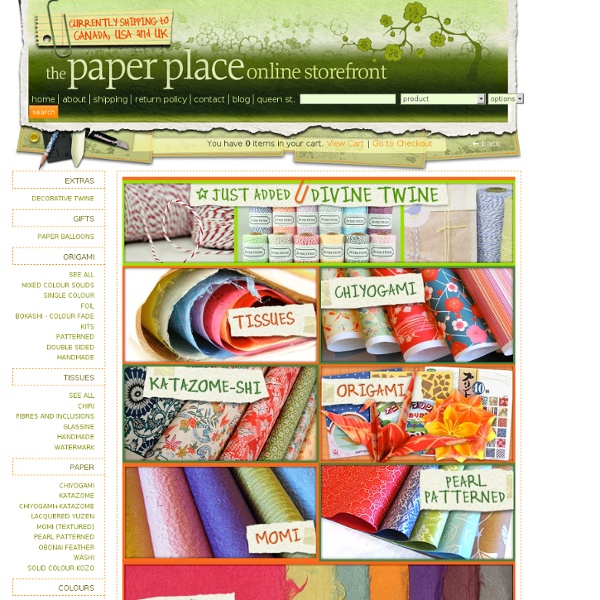



a quick tutorial : : book beads « the smallest forest I haven’t added any text instructions, because I think the photos are clear enough. All that’s left to do know is make a whole heap of these, in different shapes (but always symmetrical shapes!) and sizes, and stringing them up. This uses the same binding method used to make childrens board-books…the only difference is that you glue the front and back cover together, as well, and create a book in the round, without and ending or beginning…and that’s some pretty heavy symbolism for a pretty paper bead! Have fun! Like this: Like Loading... DIY Paper Pinwheels The incredibly sweet Jessica of In the Hushed Hours was kind enough to share this tutorial for DIY paper pinwheels. I love pinwheels. Pinwheels strung on a mobile? I might love those even more. String your paper pinwheels from an embroidery hoop to make your own mobile perfect for a bedroom or for a party. {Photos from In the Hushed Hours.}
3D Valentines Day Card Tutorial | Paper Kawaii Origami Cherry Blossom Tutorial ⬇⬇Expand for more info! ⬇⬇ Hi people! in this video I will show you how to make a cherry blossom from 1 piece of paper. If you need to learn to make a pentagon, please check out my recent video on that and come back :) Thanks for watching! Origami Pentagon Hey all, I have made a new pentagon video, hopefully this will be clearer and I am beginning to speak in my videos. Origami Star Flower Tutorial Here is a quite short video on how to make a great origami star flower, it was originally requested by someone on facebook ^_^ You will need a pentagon shape to begin with, so first go here: Then come back :P You can download the diagram for this model at my website here: Enjoy! Triangular Origami box (non modular) This triangular origami box is made using one piece of paper for the lid, and one piece for the base.
Tattered Angels | Creators of Glimmer Mist and Scrapbooking Supplies It’s the moment we have ALL been waiting for–Tattered Angels is proud to release our newest addition to the TA family, Tattered Tangles, a collection of papers that inspires coloring inside of the lines and thinking outside of the box. When we were thinking about our newest line under the Tattered Angels brand, we had two objectives in mind: 1. Create a line that served as a starting place, but was open enough to let one’s creativity run free 2. Keep the line versatile enough to allow one’s personality to guide the direction of their project Complete with (6) 12″ x 12″ papers and (6) Tattered Tangles packs (sizes vary), the papers were designed to work with any color palette. To give you better insight into this new line of papers, we sat down with TA designer JoAnne Doshier to hear her thoughts on the making of Tattered Tangles. Q: What was your inspiration for creating Tattered Tangles. A: When creating, it’s often helpful to have a place to start. A: Yes, that is what is so exciting.
Something Special Card + Envelope Tutorial We hope Jennifer Casa’s Something Special Card + Envelope Tutorial inspires you to create something beautiful for someone you love. Learn more about Jennifer in her introduction, and make a visit to JCasa*handmade part of your daily routine. After you make the basic card + envelope as a foundation piece you can then embellish, embroider, quilt, print… Do something to make it unique! Mix things up, and personalize your card to make it the perfect something for your special someone. Create your personalized fabric card or Valentine with Jennifer’s tutorial by February 12th, share it in the forum and you might win one of these fantastic prizes. From Jennifer: Our lives are overrun by email, texting, and virtual hellos-– With this simple fabric card + envelope project, I encourage you to take a step back from the everyday and make something memorable, something as one-of-a-kind as your special someone. Finished Measurements Envelope = 5.25” x 7.75” Card = 4.75“ x 7” What you need 2. 6. 9. 2.
6 Tips for Using Patterned Paper Backgrounds on your Scrapbook Pages | Get It Scrapped! by Debbie Hodge I love using patterned papers — especially for backgrounds. However, it’s often a little tricky making sure the photos aren’t overwhelmed by the paper. 1) be generous Text patterns are back, and Jennifer Wilson used “holiday-love” themed paper to set the tone for “Love Actually is all Around.” The mat is a much lighter color than the patterned paper AND than the photos on it. Love Actually is All Around by Jennifer Wilson of Simple Scrapper 2) lay a foundation The bright geometric patterned paper on the background of “Hangin’ Poolside” by Alicia Geiss is wonderful for this juicy summer page. These scalloped mats ground the other elements to the page – everything sits on or flows through them.These mats with their very pale pattern provide resting space for the eyes. Hanging Poolside by Alicia Geiss for Scrapbooks.com Foundations is the focus of Lesson #4 in Building Pages. 3) it’s ok to be busy The paper is busy and could be overpowering. 4) pop it 6) go negative
Creating Keepsakes Blog